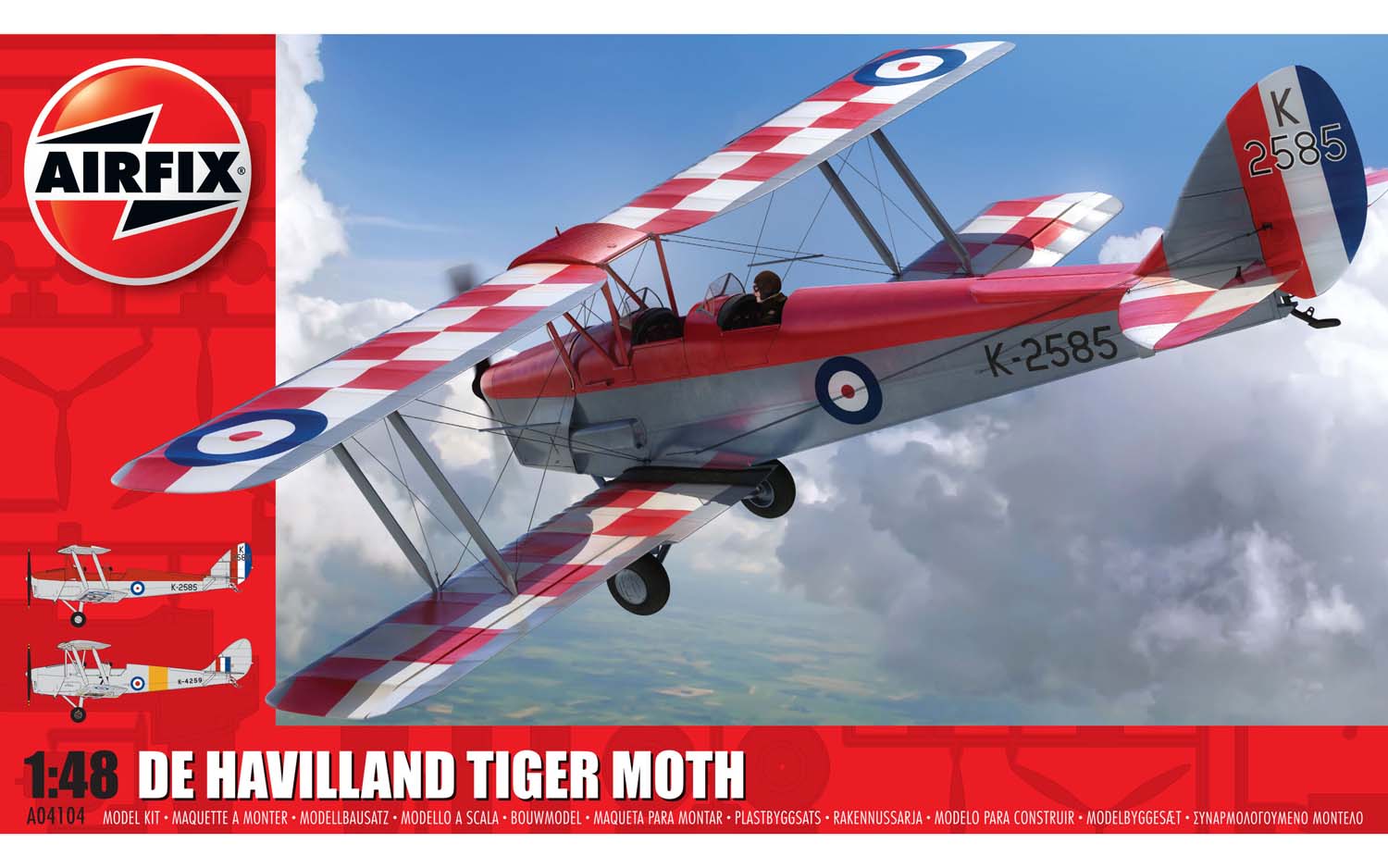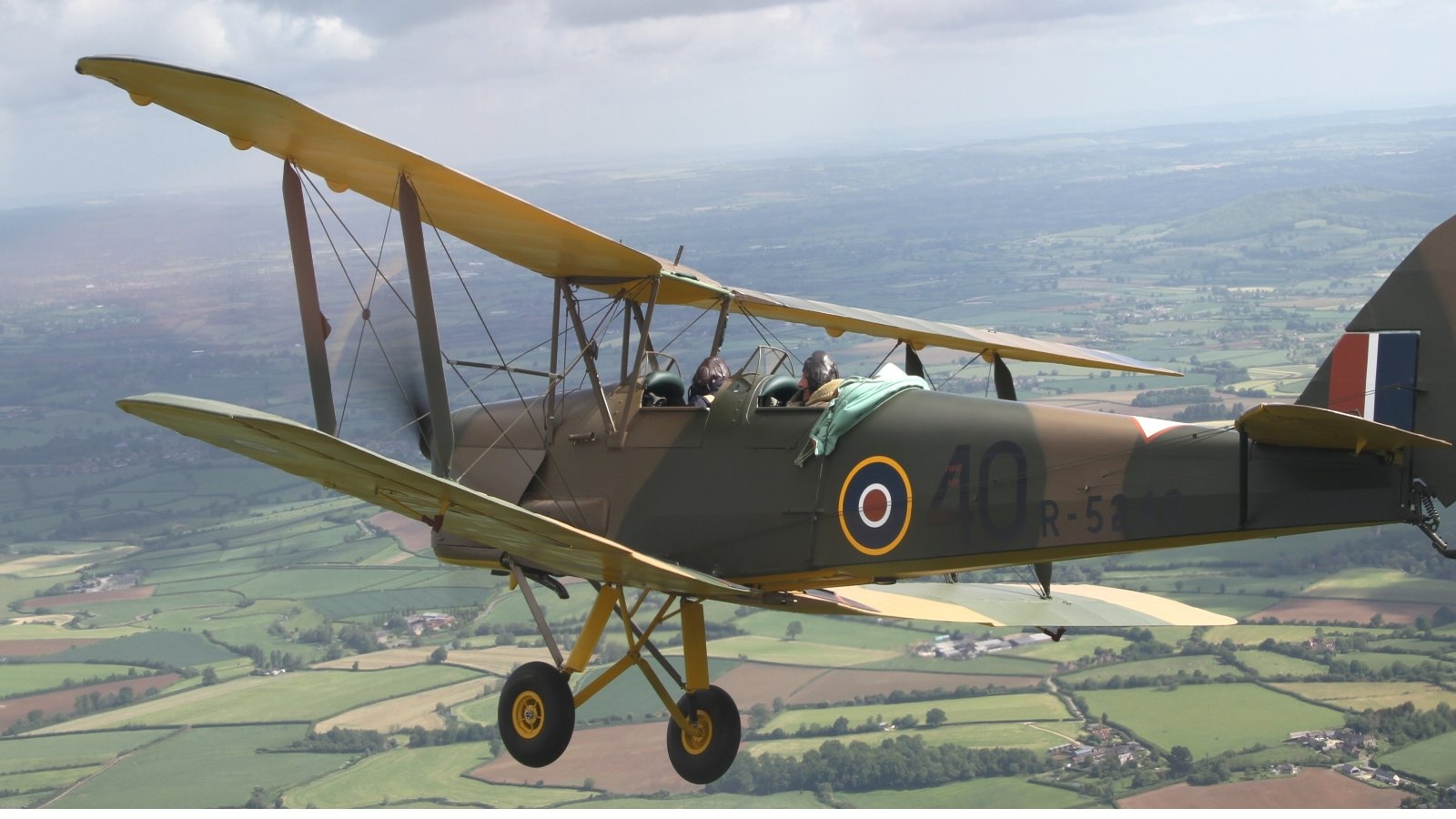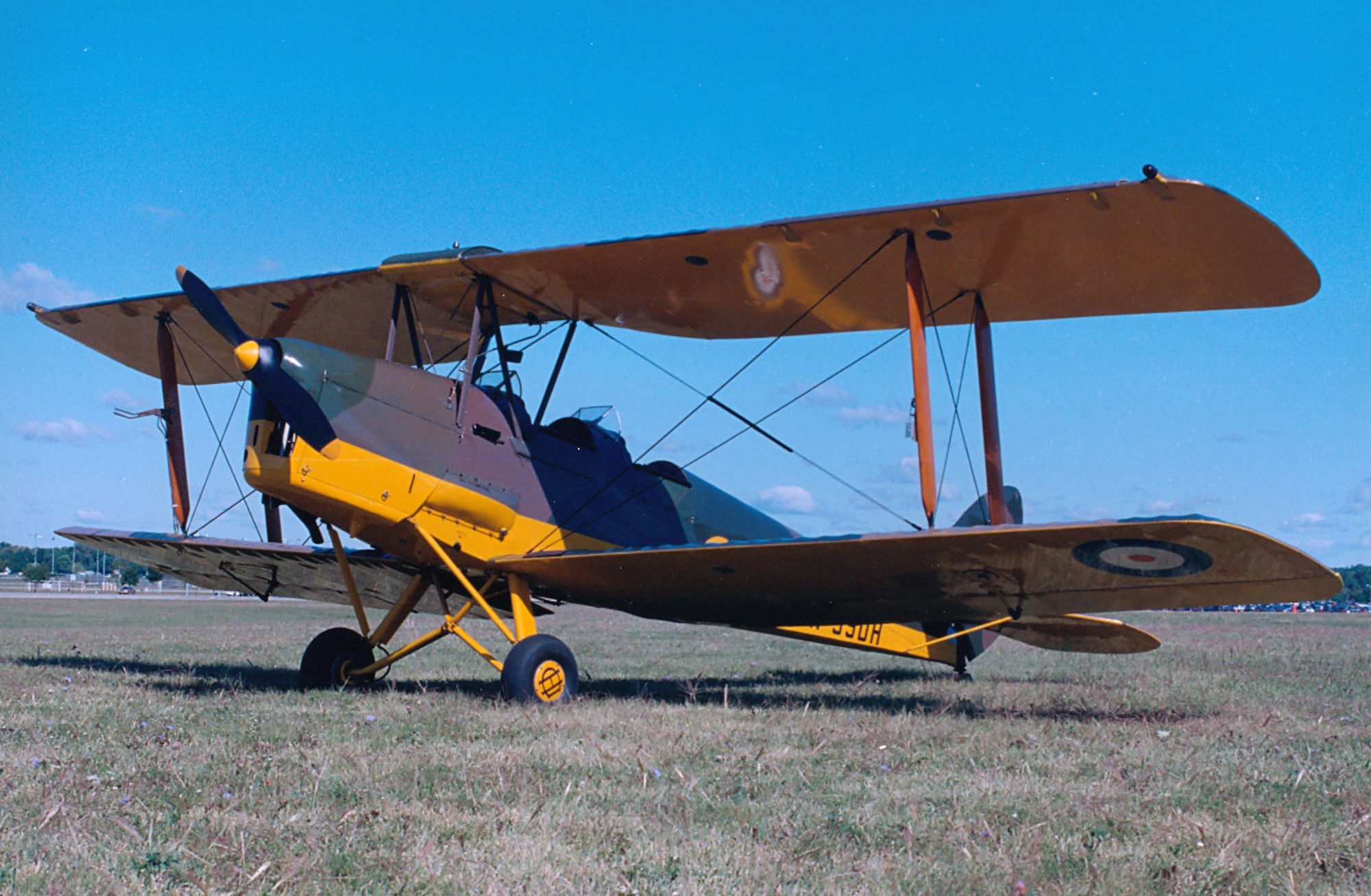Tigermoth Aircraft - For the earlier monoplane, also known as the Tiger Moth, see Havilland DH.71 Tiger Moth. For other De Havilland Moth aircraft see Havilland Moth.
"Tiger Moth" redirects here. For the moth group, see Arctiini. For other uses, see Tiger Moth (reference).
Tigermoth Aircraft

The de Havilland DH.82 Tiger Moth is a 1930s British biplane designed by Geoffrey de Havilland and built by the de Havilland Aircraft Company. It was used by the Royal Air Force (RAF) and other operators as a primary training aircraft. In addition to the main type's use for ab initio training, RAF Tiger Moths saw service in other capacities during the Second World War, including maritime surveillance and defensive preparations against invasion; some aircraft were equipped as armed light bombers.
Dh 82a Tiger Moth
The Tiger Moth served the RAF until it was replaced by the de Havilland Chipmunk in the early 1950s. Later many surplus military aircraft were used for civilian operations. Many nations have used the Tiger Moth in both military and civilian applications, and it is still widely used as a recreational aircraft. It is still occasionally used as a primary training aircraft, especially for pilots who wish to gain experience before moving on to another tailwheel aircraft. Many Tiger Moths now work for companies that offer trial classes. The De Havilland Moth Club, founded in 1975, is now an owners' association offering a mutual club and technical support.
Geoffrey de Havilland, the owner and founder of the company, aimed to produce a light aircraft superior to his two previous models, the de Havilland Humming Bird and the de Havilland DH.51.
From previous experience, de Havilland knew the difficulty and importance of the correct size of such an aircraft to appeal to the civilian market such as tourists, trainers, flying clubs and private aviation clients; the company had great success with a scaled-down version of the DH.51, the de Havilland DH.60 Moth.
De Havilland successively developed more powerful Gipsy gins, and the company built a new low-wing monoplane to test them. This aircraft became the first aircraft to be called a Tiger Moth.
Fisher R 80 Tiger Moth
The improvements made to the Tiger Moth monoplane were incorporated into the DH.60 Moth military trainer variant, the DH.60T Moth - the T in addition to the word 'Trainer' stands for 'Tiger'.
The DH.60T Moth had few shortcomings and a number of modifications were made, such as the introduction of shortened interplane struts to raise the wing tips after insufficient ground clearance was discovered when it was being tested at RAF Martlesham Heath.
The Martlesham trials were followed by a favorable report on the type, which in turn led to the type soon being officially adopted as the new main trainer of the Royal Air Force (RAF). One prototype, designated DH.82 Tiger Moth, was ordered by the British Air Ministry under specification 15/31, who were looking for a suitable ab initio training aircraft.

One of the main changes compared to the previous Moth series was improved access to the forward cockpit, as training requirements stated that the front seat passenger must be able to escape easily , especially when wearing a parachute.
Valueplanes Balsa 1:3.8 Dh82a Tiger Moth Kit, 2.36m Wingspan
Access to the forward cockpit of the Moth's predecessors was limited by the aircraft's fuel tank located just above the forward cockpit and the support of the -rear cockpit for upper wing. The solution was to move the upper wing forward and sweep the wing back to maintain the same lift ctre.
Other changes included a stronger structure, folding doors on both sides of the cabin and a revised exhaust system.
On 1931 26 October the first "real" Tiger Moth, the E6 prototype, flew at Stag Lane Airfield, Edgware, London, flown by de Havilland chief tester Hubert Broad.
Shortly after the publication of specification T.23/31, the first 35 aircraft of the RAF series, designated K2567-K2601, began construction; in addition, two floatplanes, S1675 and S1676, were built to specification T.6/33.
Tiger Moth Flight In Kent
The de Havilland DH.82 Tiger Moth is a light biplane biplane. It was developed mainly for private travel customers as well as pilot training for military and civilian operators. It is normally powered by a de Havilland Gipsy III 120 hp engine; later models often have more powerful versions of this genie, and some have been remanufactured by third-party companies.
One design feature of the Tiger Moth is the differential aileron control setup. The Tiger Moth's ailerons (lower wing only) are controlled by an externally mounted circular bell crank, which is flush with the underside of the lower wing fabric. This circular bell crank is surrounded by metal cables and chains from the cockpit control columns, and an externally mounted aileron pusher is mounted 45° behind the bell crank when both ailerons would be neutral. As a result, the aileron control system operates with almost no downward movement on the wing on the outside of the turn, while the aileron on the inside moves up to avoid a negative turn.
From the beginning, the Tiger Moth proved to be an ideal simulator, simple and cheap to have and maintain, although the control movements required positive and reliable hands, since the inputs were slow to control. Some instructors preferred these flight characteristics because they "weeded out" the unfit student pilot.

Royal New Zealand Air Force Tiger Moth aircraft with blind flying pod for instructor training, early war
Book A Flight
The Tiger Moth quickly became a commercial success, with examples sold to over 25 air forces.
In addition to military demand, aircraft were also produced for the civilian market. At one point, the flow of orders for the Tiger Moth actually consumed almost all of de Havilland's capacity to produce the aircraft, and little capacity could be spared for domestic customers.
In 1932 de Havilland also developed an affordable air taxi from the Tiger Moth, using many of the main components of the first, with a new plywood fuselage accommodating four people in an enclosed cabin; it was marketed as the de Havilland Fox Moth.
After all production ended, Tiger Moths were converted by third parties into a Fox Moth-like configuration, such as the Thruxton Jackaroo.
Dh82 Tiger Moth Vh Pcl
In late 1934, 50 Tiger Moths of a more advanced design, sometimes called Tiger Moth II, were delivered to the RAF; These planes used the de Havilland Gipsy Major engine, capable of developing 130 hp, and the rear fuselage used plywood decking instead of fabric.
During 1934-1936 During the period, production activities were carried out to meet the demand for military trainers, including several contracts awarded by the RAF for the T.7/35 specification and export orders from seven foreign operators .
Civilian examples were also produced at this time both for British private customers and for export customers in countries such as Ceylon, Greece, Lithuania, Rhodesia, Peru and the -Switzerland.

After 1936 the gradual ramp of Tiger Moth production reached the point where production capacity could finally exceed the needs of military customers only.
Tiger! The De Havilland Tiger Moth
By the start of World War II, a total of 1,424 Tiger Moths had been produced through domestic and foreign production efforts.
In 1941 de Havilland transferred the main Tiger Moth production activity from its Hatfield factory to Morris Motors Limited at their factory in Cowley, Oxford.
In 1945 The production British Tiger Moth was released; up to this point, Morris Motors had completed a total of 3,433 Tiger Moths.
Abroad, this type of production began in 1937; the first builder outside of this was de Havilland Canada at its facility in Downsview, Ontario. In addition to the initial batch of 25 Tiger Moths that were built for the Royal Canadian Air Force (RCAF), the Canadian company began to build fuselages that were exported to the United Kingdom for completion.
Airplanes > Tiger Moth Version 1.10 For Msfs. Payware (updated Oct 2022. Released Sep 2022)
The Canadian-built Tiger Moths were modified to better suit the local climate, including a strengthened tailwheel, handbrakes (designed by Bdix Corporation), shorter landing gear radius rods and landing gear legs main turning forward. rollover protection in advance when braking. Additionally, the cabin featured a large sliding canopy, equipped with exhaust-based heating; Several alternative chassis arrangements were also offered.
Prior to Canadian production, de Havilland Canada produced a total of 1,548 of all versions, including the DH.82C and the American Masco Pirate ginned variant (with the 'right'/'counter-rotating Gypsy Major -clockwise' left/clockwise), known as the Masked Moth; it also included 200 Tiger Moths built on wartime US Army Air Forces (USAAF) Ld-Lease orders that were assigned to the bureaucracy as PT-24s before being delivered to the RCAF.
There was also additional foreign manufacturing activity, most of which occurred during the war. de Havilland Australia assembled an initial batch of 20 aircraft from UK parts before embarking on the main DH.82A production campaign, resulting in a total of
Dodson aircraft salvage, avemco aircraft salvage, dawson aircraft salvage parts, aircraft insurance salvage sale, aircraft insurance salvage, aircraft salvage companies, aircraft salvage, aircraft salvage parts, aircraft insurance salvage auctions, aircraft salvage yards, aircraft salvage auction, aircraft salvage yards texas

0 Comments